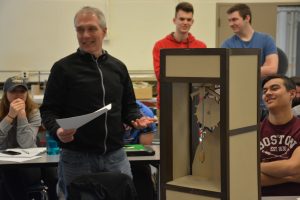 An interesting thing happened in my Computer Aided Manufacturing class recently. In the spirit of EPIC—an initiative at Wentworth which promotes collaborative, interdisciplinary learning–this class combines engineering and industrial design students in mixed teams, taught by faculty from both disciplines who challenge students to employ engineering, design and manufacturing solutions.
An interesting thing happened in my Computer Aided Manufacturing class recently. In the spirit of EPIC—an initiative at Wentworth which promotes collaborative, interdisciplinary learning–this class combines engineering and industrial design students in mixed teams, taught by faculty from both disciplines who challenge students to employ engineering, design and manufacturing solutions.
During this particular session we were critiquing the concepts of each of the student teams and, as is customary at the early stages of the design process, the work that we were looking at consisted of conceptual sketches. We asked the students to come to class the following week with prints which would reflect deeper thought and less ambiguity so that we could begin to focus our critiques on the details of their solutions.
Then it happened . . . “Professor? By prints, do you mean 2D prints or 3D prints?” It occurred to me at that very instant that we were talking about removing ambiguity from their designs and yet the very word that we have used for years, “prints,” was suddenly ambiguous.
3D printing has become so pervasive and commonplace that we must now qualify what we mean when we use the word “print.” For those of us in the engineering and design profession, this is no surprise and it is an indication that 3D printing is here to stay. However, 3D printing is no longer just the little darling of the prototyping world. It has grown up and has a new name: Additive Manufacturing.
In fact, not only does it have a new name, but it now has a newly approved, one semester, four credit course at Wentworth, Intro to Additive Manufacturing, dedicated to providing students with a useful foundation of knowledge and experience on which to build their careers. Wentworth is one of a number of higher education institutions that is a member of the Stratasys Educational Customer Advisory Board (eCAB). As a group we have worked together to create the curriculum, content, and examinations leading to a Level 1 Certification Exam in Additive Manufacturing.
According to McKinsey & Company, Additive Manufacturing is poised to have an economic impact of $100B – $250B per year beginning in 2025. That’s right, somewhere in the neighborhood of a quarter of a trillion dollars per year and 2025 is just around the corner. In preparation for this, not only has Wentworth approved a new course (with more to follow), but it has committed nearly 2500 square feet of lab space and well over $1M of additive manufacturing equipment to be located in its new Multi-Purpose Academic Building scheduled to open in January 2019.
This lab will house equipment capable of printing in standard, engineering, and high-performance thermoplastics; continuous carbon fiber, Kevlar, and fiberglass composites; multi-material, multi-color photopolymers; metals and ceramics. It will provide hands-on experience with FDM, PolyJet, SLA, SLS, MJF, sintering, and post-processing equipment.
Why is this so important to Wentworth? As the opportunities for additive manufacturing continue to grow, so too will the demand for a knowledgeable and skilled workforce. A leader in education for the built environment, Wentworth wants to be proactive in meeting that demand and preparing students to actively participate in this important field with so many potential opportunities.
Here is a sample of the industries that are already being impacted and are taking advantage of additive manufacturing: Aerospace, Automotive, Consumer Products, Medical, Dental, Robotics, Pattern Making/Foundry, Injection Molding, Industrial Design, and Architecture. The list goes on and is only limited by the number of creative people who have the knowledge base to apply all of this new technology.
The demand is growing, the time is right; be a part of it.
Oh yeah, we really meant 2D prints when we were speaking to the students. The 3D printing comes a little later in the course.
Steve Chomyszak is an Assistant Professor, Department of Mechanical Engineering, at Wentworth Institute of Technology and has his Bachelor of Industrial Design from Syracuse University and his Master of Science, General Engineering from Stanford University. Steve has 25 years of industrial experience designing, engineering, building, and testing unique positive displacement machines. He has been at Wentworth since 2012.